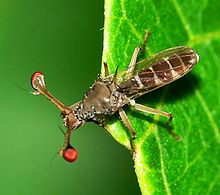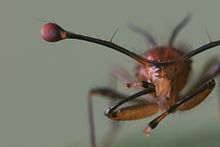- Stalk-eyed fly
-
Stalk-eyed flies 
A diopsid from Cameroon Scientific classification Kingdom: Animalia Phylum: Arthropoda Class: Insecta Order: Diptera Suborder: Brachycera Infraorder: Muscomorpha Section: Schizophora Subsection: Acalyptratae Superfamily: Diopsoidea Family: Diopsidae Genera About 11 living, including:
- Cladodiopsis
- Diasemopsis
- Diopsis
- Eosiopsis
- Eurydiopsis
- Sphyrocephala
- Teleopsis
- Teloglabrus
Stalk-eyed flies are insects of the fly family Diopsidae. The family is distinguished by the possession of eyestalks: projections from the sides of the head with the eyes at the end. Some fly species from other dipteran families such as the Drosophilidae and Tephritidae carry similar structures but the unique character of the Diopsidae is that the antennae are carried next to the eye at the end of the stalk. A rather remarkable feature of stalk-eyed flies shortly after emerging from their pupae, is the ability of the males to ingest air through their oral cavity, and pump it through ducts in the head and through to the tips of the stalks, thereby elongating them while they are still soft and transparent.[1] There are several hundred species in the family, with the greatest diversity found in the Old World tropics[2] They are distributed throughout the region, with the best known species being from South-East Asia and Southern Africa. There are also two species in North America and a European species has recently been found in Hungary.[3] Adult diopsids are typically found on low-lying vegetation in humid areas, often near streams and rivers, where they feed on fungi and bacteria on decaying vegetation. The larvae develop in rotting vegetation. Due to their peculiar morphology, stalk-eyed flies are readily identifiable as fossils (e.g. in amber); one such prehistoric genus is Prosphyrocephala. An African genus Centrioncus once placed in the Sepsidae and then moved to the Diopsidae had been suggested as belonging to a proposed new family Centrioncidae as a sister group of the Diopsids[4] but this is usually treated as a subfamily.[5]
Contents
Sexual selection
These flies are regarded as classical examples of sexually selected animals. Many species are sexually dimorphic for the length of the eyestalks, with males having much longer eyestalks than females, and this dimorphism is believed to have evolved because of the mating advantages that they bestow on these males. The most widely studied species of diopsid is the Malaysian species Teleopsis dalmanni (until recently called Cyrtodiopsis dalmanni and Diopsis dalmanni[6]). These insects roost at night on root hairs hanging by streams, and mating usually takes place in the early morning at these sites. Females show a strong preference for roosting and mating with males with longer eyestalks, and males compete with each other to “control” these lekking aggregations by a ritualised contest that involves facing each other and comparing their relative eyespans, often with the front legs spread out to add emphasis. Male T. dalmanni with long eyestalks therefore gain mating advantages both because of female choice and because of they are better able to compete with rival males.[2][7]
Research
 Teleopsis sykesii from the Western Ghats of India
Teleopsis sykesii from the Western Ghats of India
Early research on the Diopsidae concentrated on the visual consequences of the unusual position of the eyes, with emphasis on the flies' field of view and ability to judge distances.[8][9] More recently these flies have become important laboratory models for testing theories about the evolution of secondary sexual characters, with important work being carried out at the University of Maryland in the USA and at University College London, in the UK. Research in these labs has shed light on a number of important questions in evolutionary biology, in particular the question of why female choice for apparently arbitrary male characters should evolve. Diopsid eyestalk length has been shown to be strongly condition dependent in males, meaning that high quality (see also Fitness) males are able to grow large eyestalks even under stressful conditions.[10] Females who mate with these males will therefore benefit by acquiring these good alleles for their offspring. Furthermore, in some populations of T. dalmanni female flies carry a meiotic drive gene on their X-chromosomes that causes female-biased sex ratios. In these populations males that have gene that suppresses meiotic drive have longer eyestalks, meaning that females that prefer to mate with these males will gain a direct genetic benefit by producing male offspring in a female-biased population.[11] In other words, the gene for long eye-stalks is close for a gene which allows males to sire more males, so mating with a long-stalked male increases the chance that a female's offspring will be male (which is advantageous in a female-dominated population).[12] Alternatively, long stalks may signal fertility, perhaps by encouraging females to use the sperm of a long-stalked male.[12]
References
- ^ "Life (BBC TV series) - Episode 1: Challenges of Life"
- ^ a b G. S. Wilkinson & G. N. Dodson (1997). "Function and evolution of antlers and eye stalks in flies". In J. Choe & B. Crespi. The Evolution of Mating Systems in Insects and Arachnids. Cambridge: Cambridge University Press. pp. 310–327. ISBN 0-521-58976-2.
- ^ L. Papp, M. Földvári & P. Paulovics (1997). "Sphyracephala europaea sp. n. (Diptera: Diopsidae) from Hungary represents a family new to Europe". Folia Entomologica Hungarica 58: 137–146.
- ^ Feijen, H.R. (1983). Systematics and phylogeny of Centrioncidae, a new afromontane family of Diptera (Schizophora). 202. pp. 1–137. http://www.repository.naturalis.nl/record/317859.
- ^ Meier, R. & Hilger, S. (2000). "On the egg morphology and phylogenetic relationships of Diopsidae (Diptera: Schizophora)". Journal of Zoological Systematics and Evolutionary Research 38 (1): 1–36. doi:10.1046/j.1439-0469.2000.381128.x.
- ^ "Curran, Charles Howard". American Museum novitates 833. 1936. hdl:2246/2148.
- ^ T. Chapman, A. Pomiankowski & K. Fowler (2005). "Quick guide: stalk-eyed flies". Current Biology 15 (14): R533–R535. doi:10.1016/j.cub.2005.07.015. PMID 16051154. http://www.current-biology.com/content/article/fulltext?uid=PIIS0960982205007542.
- ^ D. Burkhardt & I. de la Motte (1983). "How stalk-eyed flies eye stalk-eyed flies: Observations and measurements of the eyes of Cyrtodiopsis whitei (Diopsidae, Diptera)". Journal of Comparative Physiology A: Neuroethology, Sensory, Neural, and Behavioral Physiology 151 (4): 407–421. doi:10.1007/BF00605457. http://www.springerlink.com/content/h9t2k9k20x7u4014/.
- ^ I. de la Motte & D. Burkhardt (1983). "Portrait of an Asian stalk-eyed fly". Naturwissenschaften 70 (9): 451–461. doi:10.1007/BF01079611. http://www.springerlink.com/content/m220527210781531/.
- ^ P. David, T. Bjorksten, K. Fowler & A. Pomiankowski (2000). "Condition-dependent signalling of genetic variation in stalk-eyed flies". Nature 406 (6792): 186–188. doi:10.1038/35018079. PMID 10910358. http://www.nature.com/nature/journal/v406/n6792/abs/406186a0.html.
- ^ G. S. Wilkinson, D. C. Presgraves &. L. Crymes (1998). "Male eyespan in stalk-eyed flies indicates genetic quality by meiotic drive suppression". Nature 391 (6664): 276–279. doi:10.1038/34640. http://www.nature.com/nature/journal/v391/n6664/abs/391276a0.html.
- ^ a b Zimmer, Carl (2008). "The Evolution of Extraordinary Eyes: The Cases of Flatfishes and Stalk-eyed Flies". Evolution Education and Outreach 1 (4): 487. doi:10.1007/s12052-008-0089-9.
External links
Categories:- Flies
- Insect families
Wikimedia Foundation. 2010.


